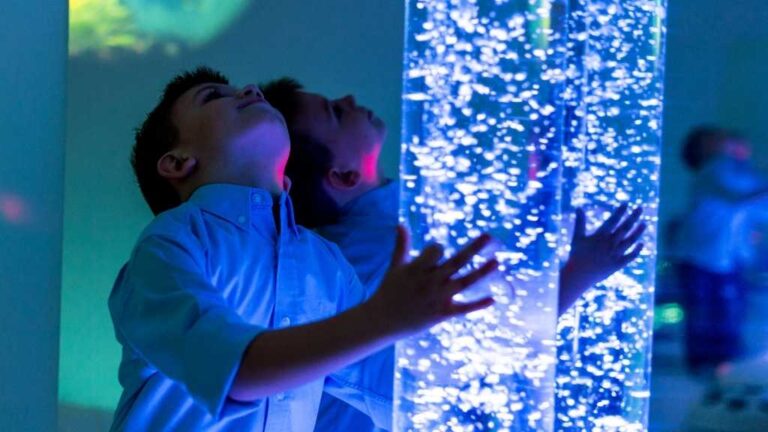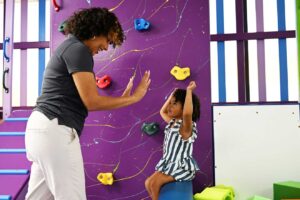Sensory rooms for autism are typically a space in a home, facility, or classroom specially designed to inspire, engage and improve the sensory experience for a child in a safe manner. This designated area engages the child’s senses by employing structured stimuli to spark their interest and promote positive feedback. The room often includes special lighting, colors, soft sensory play objects, sounds, and, in some cases, aromas. This is done in an established environment that allows the individual to interact with stimuli without risk. We will explore the benefits of a sensory room and how you can make one of your own!
What are the benefits of sensory rooms for autism?
Sensory rooms are especially beneficial to individuals with autism, learning disabilities, developmental disabilities, or sensory processing impairments. These spaces help children learn how to interact with the world surrounding them in a safe way that offers consistency and possesses no risk. The child gets free range in the area at their leisure. This freedom allows the teacher, therapist, or caregiver to observe what the child finds calming or exciting. It also helps to observe what the individual does not prefer.
Additional benefits of sensory rooms for autism:
1. Increases opportunities for interaction.
One of the best benefits of a sensory room is that it promotes the likelihood of interactions because it can be used solo or in a group. Using a sensory room with others encourages the use of socialization skills in a safe, calm, and welcoming environment. When making a sensory room in a school or at home, it is essential to consider how a group may communicate effectively. Sensory rooms for autism may include cause-and-effect toys and games that foster turn-taking and socialization within the room.
2. Stimulates various senses.
Sensory rooms for autism surround the individual with sensory experiences, like colors, textures, lights, and smells. Doing so in a controlled environment can positively affect many with autism. It improves the child’s ability to understand, react and interact with their environment. It also naturally increases their tolerance for stimulation.
A child might be too nervous to try a swing on the playground, but they may be more inclined to cooperate in a calming room where the swing is shaped like a cocoon. This same thing goes for sharing and taking turns. In a busy classroom, convincing your child to share may be challenging, but in the sensory room, where they feel safe and know they are getting the toy back, they will engage in the group experience.
3. Improves movement, sense of orientation, coordination, and balance.
Sensory rooms for autism assist individuals in various processes while helping them work on their gross and fine motor skills. These skills are essential because they help children with their day-to-day living. For example, tying their shoes allows them to change locations and dress independently. Sensory rooms are also beneficial for children with additional physical difficulties like impairments or other physical conditions because they can help with muscle tone and relaxation.
4. Sharpens concentration.
Some individuals with autism find it difficult to focus, especially concerning nonpreferred activities. This is also a common trait of ADHD. Sensory toys and equipment are designed to help individuals focus on the activity they are engaged with. Their focus should be enhanced in a well-designed sensory room with no competing attention. Every experience is accessible and soothing. This increases the child’s comfort, making it easier to focus. Concentration is essential for children to develop and cope with real-world situations.
If the child does not get practice focusing their attention, it can have fatal effects. Being a part of the outside world requires being able to concentrate at times. If a subway car catches fire, for example, getting up and leaving the vehicle is essential. This requires focus and attention. Without these skills, individuals with autism can miss necessary signals that can carry long-term consequences.
5. Helps decompress, relax the mind, and calm down.
Sensory rooms for autism are highly absorbing, providing children with a much-needed moment of calm and comfort in case of overactivity and distress. Additionally, because of the safe and controlled nature of the room, those that isolated may feel comfortable and soothed enough to engage with their surroundings.
6. Manages challenging behaviors.
If a child has a meltdown, a trip to the sensory room can help give them a dose of calm. Once in the room, they can engage with soft toys and activities. Additionally, sensory rooms for autism are often filled with toys the child does not usually gain access to, making it a motivating and valuable experience. Going to the sensory room should be alleviating and special but not overused!
7. Teaches through play.
Many sensory rooms for autism are designed with learning in mind. But parents and providers should also ensure fun is a priority in the sensory room. Sensory play aids children in developing their senses, problem-solving, and building nerve connections in the brain. Additionally, unique toys in the sensory room will engage children’s brains in diverse ways, which helps children absorb and retain more.
Examples of teaching through play may be a light-up sorting toy or listening to music about numbers. There are so many ways to include learning while making things fun! Check out autism specialty stores when shopping for toys to fill the space.
Steps to Build a Sensory Room at Home:
1. Location
When you begin designing your sensory room, the first thing to consider is where you want the room to be located. It is highly recommended that the room be away from the busy areas of the house or school to ensure external noise is not an issue. Select a room that does not have windows. Windows in sensory rooms for autism are unnecessary because they are mostly covered with blinds or films to control the atmosphere.
2. Size and shape
When planning your room, ensure you know what you want to put in the room. Sensory rooms for autism can be as small as a walk-in closet, but planning is essential. Consider using ample space if you have many ideas and toys you would like to include. Lastly, consider the shape of the room. For example, if you are mounting light displays, you will not want to select a circular room.
3. Ventilation, heating, and cooling
Ensure the room is breathable if the heat is emitted from electrical lighting products. Professionals advise you to include an air conditioning unit in your space. It will also be helpful to have a thermostat in this room. If that is not possible, include a ventilation system that allows fresh air flow.
Additionally, sensory rooms for autism should include adequate heat. Having a well-ventilated room that is heated and cooled as needed helps the individual and caregiver or therapist focus on the experience at hand and not on the environmental features of the room.
4. Lighting and Sound
In many cases, fluorescent light emits an undesirable noise which can increase stress in individuals. Softer lights are typically a better choice for a sensory room. Also, it would be great if the light could be dimmable.
Sound insulation can help prevent unwanted noisy distractions from entering or leaving the room. Sound insulation can be achieved by using various materials, thickening the wall, or even lining them with sound-dampening materials.
5. Color of walls, ceiling, and floor
Color the walls to suit your child’s favorite colors, or choose colors based on the mood you want to convey. Consider leaving the wall white if you use a projector in your room. Try implementing dark blues or green if you are going with a darker space. Dark colors make for more focused areas in which you can include ultraviolet lights. You can also pick colors according to a theme.
6. Floor coverings
Select a floor coloring that can be used throughout the room. If you use wheelchairs in the room, select a durable floor where the wheelchair can move. Combine carpets and vinyl floors for tactile effects. Put a mat in the corner of the room and add lots of pillows for a lounging or mindfulness area.
ABA Therapy and ABA Centers of Florida
Sensory rooms can be a prominent feature and asset of a facility and make all the difference when you include them at home. Think of your sensory space as a safe, sacred place to let the mind and body unwind. ABA therapists often use sensory rooms and tools in their programs with children on the spectrum. A good ABA center will also be outfitted with toys for sensory experiences.
ABA Centers of Florida recognizes the value of sensory rooms for autism. Our staff can help you learn more about your child’s sensory needs and challenges! For information about how ABA therapy can help your child with autism, call ABA Centers of Florida at (772) 773-1975 or visit ABACentersFL.com.








